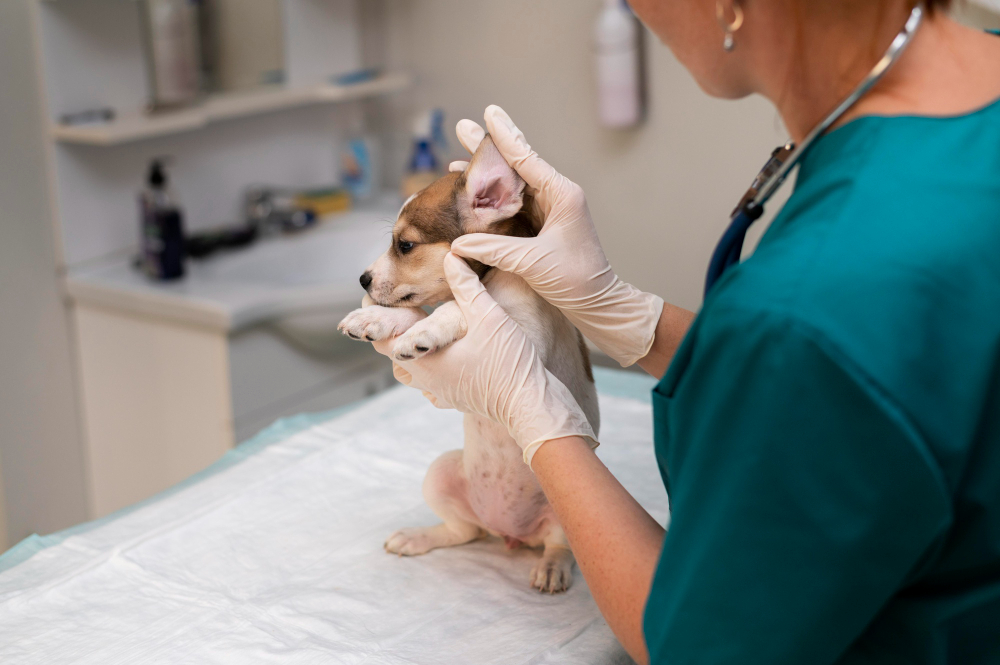Actually, many conditions in dogs can be checked at home without going to the veterinary hospital. Of course, I’m not suggesting that you skip the annual check-up for your dog at the vet. Comprehensive physical examinations are still necessary. Today, I’ll just teach you some simple ways to check your dog’s health at home. Hopefully, you can remember them so that when needed, you can help your dog assess their health by performing some simple measurements.
Skin
First, let’s start with the skin. You can have your dog sit or lie down, then gently stroke their entire body, feeling for any unusual bumps or hair loss. Also, check if there are any changes in the color of the skin. If everything looks normal, congratulations, your dog’s skin is healthy! However, if you notice any abnormalities, it’s important to address them accordingly and seek treatment for any skin conditions.

Dehydration
Detecting dehydration in dogs is quite simple. You can gently pinch the skin on the back of your dog’s neck. Don’t worry, this area of the skin is relatively loose, so your dog won’t feel uncomfortable. The main purpose of pinching is to observe the elasticity of the skin. Normally, the skin should immediately return to its original position after being pinched. However, if it takes a while to return to normal, it indicates that your dog may be dehydrated. In such cases, it’s important to promptly take your dog to the veterinary hospital for fluid replacement therapy.

Heartbeat and Temperature
Pet owners can actually measure their dog’s heartbeat at home. As shown in the image, use four fingers to lightly press on the inside of the dog’s thigh. This can effectively measure the dog’s pulse. You can also use Petority’s smart collar to measure your dog’s heart rate more accurately. Normally, an adult dog’s heartbeat is between 70-110 beats per minute. Counting for a minute will give you your dog’s heart rate.

As for measuring a dog’s temperature, it’s even easier. If you have a thermometer at home, cover it with plastic wrap and insert it into the dog’s anus to measure its temperature. Normally, a dog’s temperature will be around 38-39 degrees Celsius. If it exceeds this range, pet owners should be concerned and it’s best to take the dog to the veterinary hospital for examination.

Eyes
When it comes to your dog’s eyes, you can start by observing their appearance. Check if there is any redness, tearing, frequent blinking, or asymmetry in the pupils. Also, pay attention to whether the reflection of light in both eyes is the same and if there are any issues such as cloudiness. These could be basic signs of eye problems in dogs.

Nose
In addition to observing whether your dog’s nose has any swollen wounds, you should also check for coughing or sneezing. As a pet owner, you can also hold a small mirror or piece of glass in front of your dog’s nose to see if there is any fogging on the surface. This can indicate breathing issues. Also, observe if your dog extends its neck and possibly makes loud breathing sounds, resembling breathing difficulties. This could indicate a blockage in the nose or problems with the trachea.

Here’s a friendly reminder: many pet owners may think that a dry nose in dogs without moisture indicates the dog’s body is unhealthy. However, in reality, a dog’s nose can become dry when they are sleeping or relaxed. Therefore, this alone cannot be used as a criterion for assessing a dog’s health.
Belly
In our daily observations, we can actually check if our dog’s belly is swollen, bloated, or drooping. The easiest way to distinguish between obesity and abdominal swelling or fluid accumulation is by touching the dog’s belly. If the dog dislikes being touched on its abdomen or if there are gurgling sounds coming from the belly, it can indicate discomfort in the abdomen.

As shown in the image above, you can first press one hand against your dog’s side and then lightly tap the other side with your other hand. If your dog has abdominal fluid, the hand pressed against the side will feel a sensation of fluid movement. Therefore, if you notice this sensation, it’s important to promptly take your dog to the veterinary hospital for abdominal fluid drainage. Prolonged accumulation of fluid in the abdomen can damage your dog’s internal organs.
Anal
You can also observe your dog’s behavior to see if they frequently rub their bottom on the ground, which could indicate anal itching or inflammation. Particularly for senior dogs, it’s important to regularly check for swelling around the anus during veterinary examinations. As dogs age, the muscles around the anus may become weaker, increasing the risk of conditions such as hernias and swelling.

All right, we’ve shared some simple at-home health check methods for dogs with everyone. We’ll continue to update more content, so stay tuned!

